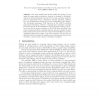Free Online Productivity Tools
i2Speak
i2Symbol
i2OCR
iTex2Img
iWeb2Print
iWeb2Shot
i2Type
iPdf2Split
iPdf2Merge
i2Bopomofo
i2Arabic
i2Style
i2Image
i2PDF
iLatex2Rtf
Sci2ools
CAIP
1995
Springer
1995
Springer
Extending the Point Distribution Model Using Polar Coordinates
The Point Distribution Model (PDM) has already proved useful for many tasks involving the location or tracking of deformable objects. A principal limitation lies in the fact that non-linear variation must be approximated by a combination of linear variations, resulting in a non-optimal model which can produce implausible object shapes. The Polynomial Regression PDM improves on the PDM by allowing polynomial deformation. However, computational complexity is greatly increased, and the model still fails for objects in which bending or pivoting occurs. We propose an extension to the PDM which selectively uses polar coordinates at little computational cost, and give examples to show that models produced are both more compact and less likely to generate implausible shapes than either of the above methods. We also give an algorithm which automatically classifies model landmark points into the Cartesian or polar domain, based on training set analysis.
Related Content
| Added | 25 Aug 2010 |
| Updated | 25 Aug 2010 |
| Type | Conference |
| Year | 1995 |
| Where | CAIP |
| Authors | Tony Heap, David Hogg |
Comments (0)

